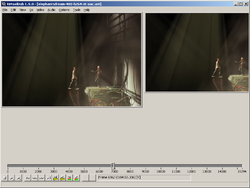VirtualDub
| VirtualDub
|
|
|---|---|
|
|
|
 VirtualDub screenshot |
|
| Basic data
|
|
| developer | Avery Lee |
| Current version | 1.10.4 (October 27, 2013) |
| Current preliminary version | 1.10.5 Beta 4 (February 24, 2014) |
| operating system | Windows |
| programming language | Assembler , C ++ |
| category | Video editing |
| License | GPL |
| German speaking | No |
| www.virtualdub.org | |
VirtualDub is free software for editing and creating video files on Windows . Pre-compiled editions of the program are available for all Windows versions from Windows 98 onwards.
overview
With "VirtualDub", author Avery Lee wanted to create fast, linear video editing with the help of a graphical user interface . That is supported primarily AVI - container format . For a long time VirtualDub only accessed the Video-for-Windows interface, which in turn usually requires a compatible codec installed beforehand . In addition to AVI, the MPEG-1 format as well as the graphic formats JPEG , BMP , TGA , PNG and JFIF are supported . In version 1.7.6 a plug-in interface was implemented for other, upgradeable file formats. In addition, VirtualDub can record the data stream from a suitable video source (such as a camera or TV card ). Regardless of the source material, VirtualDub can only save video files in AVI format.
VirtualDub provides some video filters for editing , others can be added via the plug-in interface, among others. a. Deshaker . The automatic processing of several videos ( batch processing ) can be done with the help of scripts . VirtualDub can also act as a frame server .
Modifications
For a long time, the number of video and audio formats supported by VirtualDub was comparatively small. For example, the program could not read the widely used MPEG-2 video format (standard for digital television and commercially available video DVDs ). The only remedy here was the use of a frameserver such as AviSynth , which first decoded the material and then passed it on to VirtualDub. Therefore third parties published modifications of VirtualDub, which were supplemented by the native support of other formats. The most popular representatives were Nandub (one of the first video programs with two-pass encoding based on the DivX codec in version 3.11), VirtualDubMod (a merger of many modifications, e.g. for the support of Matroska or Ogg Media ) and VirtualDub-MPEG2 (only supplemented by MPEG2 support). The development of the modifications came to a standstill, however, as VirtualDub can now be expanded using plug-ins.
Web links
- VirtualDub official website
- VirtualDub as a portable software version.
- Official website for VirtualDubMod
- An overview of common video filters for VirtualDub
- Page with various input plugins for VirtualDub (MPEG-2, ASF / WMV, AC-3, FLIC)
- VirtualDub as an installer .